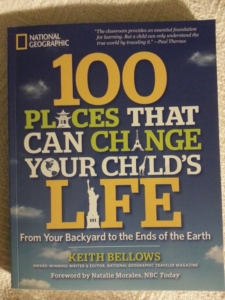The Book That Will Change the Way You Travel With Kids
As someone who writes about family travel for a living, I understand and appreciate how difficult it is to cover the subject in a way that appeals to an audience comprising diverse perspectives.
That’s why I love Keith Bellows’ new book so much.
The book, titled, “100 Places That Can Change Your Child’s Life: From Your Backyard to the Ends of the Earth” (National Geographic, 2013) takes a look at destinations that offer something for everyone. Most of the destinations (Cape Cod, Berlin, etc.) aren’t new; the format in which the book presents certain information, however, definitely is.
Destinations are organized into geographic regions, and each write-up works like a separate magazine feature. The main attraction: a service-oriented mainbar about the most family-friendly stuff to do.
In addition, peppered throughout each chapter are call-out boxes and sidebars with specific information for which any of us would kill while on the road with our kids.
Some of this marginalia includes:
- “Buy Worthy,” a box that lists authentic products that express a sense of place.
- “Fast Facts,” which incorporates nutty trivia that will surprise your kids.
- “Know Before You Go,” a compendium of books, music, movies and other media to give you the sense of a place before you buy the ticket.
- “Nest,” which comprises family-friendly hotel recommendations.
- “Yum!” which chronicles where kids will find food (and atmosphere) they’ll actually like.
Additional sidebars include information about insider tips, neat cultural objects, organizations working in the field that can provide visitors with more in-depth information and data about how you and your kids can help change people’s lives when you travel.
These sidebars are great because they’re digestible, easy-to-find and packed with worthwhile information.
They also work because they contain material that most other family travel offerings do not.
No, the book isn’t perfect. Without question, the work would benefit from more images—the only non-text specimens are icons and drawings or sketches. Also, cost is one data point that is obviously absent from the discussion, leaving one to assume that most of the trips mentioned therein cost a pretty penny. (Believe it or not, many families can’t actually afford a trip to see the Pyramids of Giza.)
Still, if for no other reason than to generate family travel ideas, this book is worth a read. Check it out.





Leave a Reply
Want to join the discussion?Feel free to contribute!